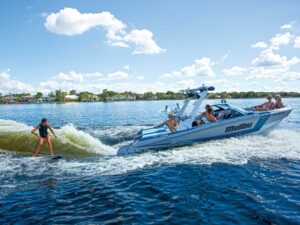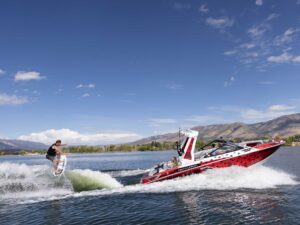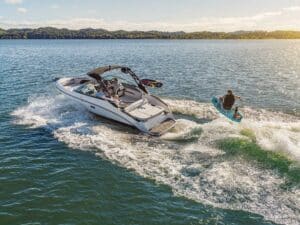Don’t you love the way a wakeboarder’s boat sits in the water? It rides low. It slithers across the lake like a water moccasin on the prowl. It idles up to the dock, full of tanned, skinny guys and Reef Brazil-like girls, then seems to say in a growling, basey, Tone Loc-like voice, “Yo, man, wha’s up?”
A water-ski boat, on the other hand, its gunnels riding high and dry, comes up like a perky cheerleader: “Hi, let’s go skeeeeing.” That’s not what you want. Where a water-ski boat skips over the water like a flat stone, a wakeboarding boat moves through the water the way a snowplow moves through a blizzard. It plows around the lake at low speeds, pushing huge wakes which mercilessly rock boats along the shore. Wakeboarding boats are the terrors of the lake – they walk softly and carry a big stick. They prowl back and forth with their extended pylons looking like a shark’s dorsal fin in the hunt for food. Eventually their presence will beat you down. The lake will never be the placid pond you used to ski on. You’ll realize that you can’t beat them, so you try to join them.
Now you can buy a wakeboard-specific boat with a wake-producing system like the Wedge, TAPS, LCS, WET or any other “system” and get a decent wake. In fact, any of the wakeboard specific boat can produce a really good wake if you use them the way the manufacturer envisioned – with a crew full of wake-hungry boarders. But who wants to carry seven people in his or her boat for that extra thousand pounds? If you carry seven people, you only get to ride every seventh time. You will learn very early in your wakeboarding life that weight is a nice substitute for people because weight doesn’t ride. It doesn’t pay for gas, but it also doesn’t take up your precious water time.
Weight
We’re not going to fool you. The wakeboard-specific boats are good, but you are still going to want to add weight. The obvious thing to do is to buy a water bag and throw it in back of your boat. That’s so 1995.
What you want to do is what Shannon Best does with his Supra Sun Sport. He maximizes the wake and minimizes the amount of wake-producing items lying around the boat. Best uses a combination of five-gallon gas-tank drums of wetted sand and water bags. He places them all out of sight – four five-gallon tanks (about 200 pounds) in the ski locker above the gas tank and a water ballast under the seat. He uses another five-gallon drum for balance to adjust the wake. Between the driver’s and passenger’s seats there is a water bag, and then right in the bow are two additional five-gallon drums. Best says he tries to have just as much weight in the front as the back because putting all the weight in the back makes the boat drive poorly. Plus, when you get the bow in the water, the extra vee in the nose helps displace more water and make yet a bigger wake.
Cobe Mikacich says the main objective is to sink as much of the hull as you can. With the wakeboard-specific boats, the wake shape is usually good; the question is just how big to make it. Putting weight only in the back makes the wake too “peaky.” On smaller boats that can’t hold a lot of people or weight, if you weigh it down enough to make the wake a good size, it starts to curl. Wakeboard-specific boats usually have a nice, crisp, clean wake, plus they can handle the extra weight. Cobe’s boat, for example, is Coast Guard-approved for 13 people.
Boat Speed, Line Length
A funny thing happens when you build up a wake to the point that it makes you get more air. You have to go faster to clean up the face so it’s not all white water. Then, when you go faster, you have to make your line longer to put you in the right part of the wake. Where does it stop? Take a look at Gator’s setup – something like 24 mph and a 75-foot rope. Most mortals couldn’t get to the middle of the wake.
Common knowledge used to be that you pull a wakeboarder at 18 mph with a 47-foot (28-off) line. But when you weigh the boat down, you probably are going to want to go 20 mph or even 22 mph and ride at least a 60-foot line. Once you start going big, like you will with your amped-up wake, you’ll want to ride a wider point in the wake because it makes you land on the downside of the wake, which is softer than landing in the flats.
Extended Pylons
Don’t even think about not using one. Just like a shorter line pulls you down more quickly, a shorter pylon kills your air time.









